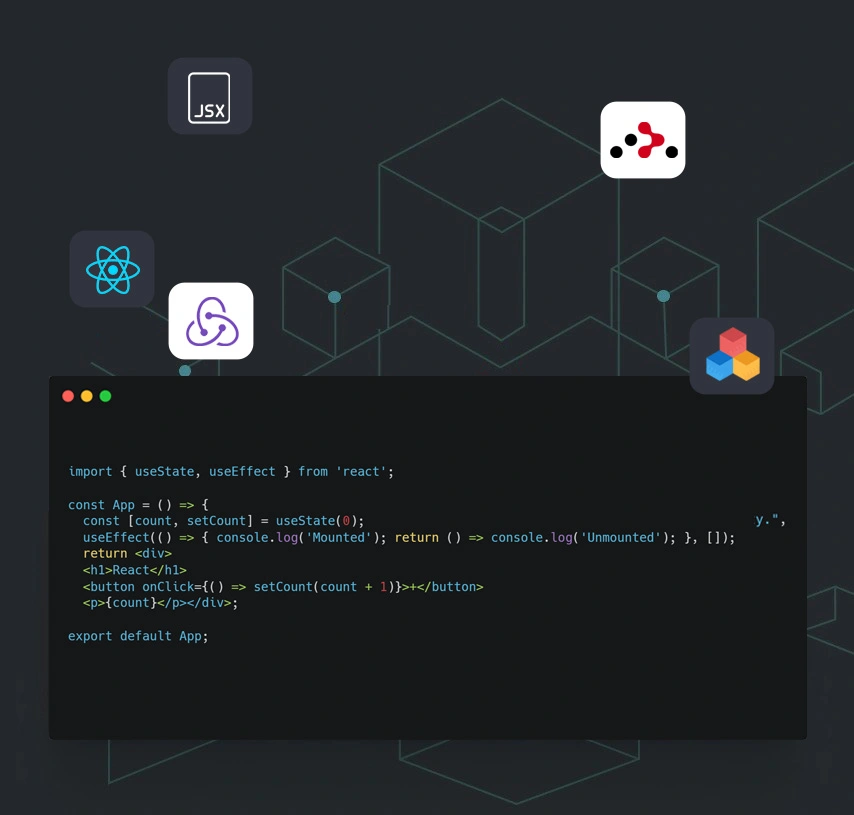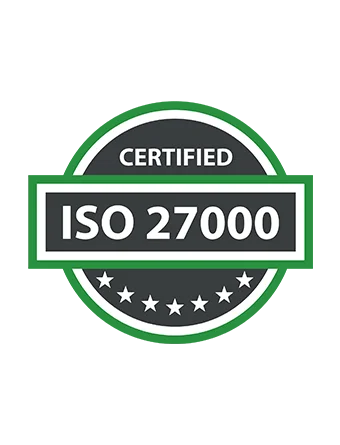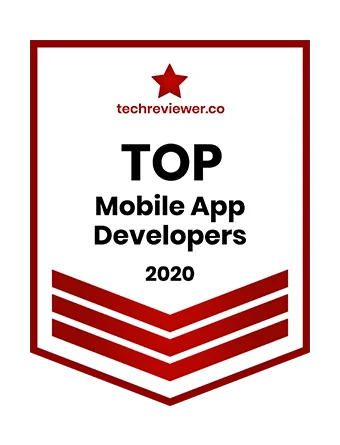The right agency for your project providing success with every solution
600+
Project completed


Project completed
VOCSO builds interactive, responsive interfaces using ReactJS, AngularJS, VueJS, custom CSS etc. Our services include UI/UX design, SPAs, PWAs, and more, crafted for great user experiences.
Get full-stack application development with MEAN Stacks. VOCSO delivers robust, scalable solutions customized to your business requirements.
At VOCSO, we develop secure, scalable, and high-performance back-end to power your web and mobile apps, ensuring speed, stability, and seamless integration.
From concept to launch, VOCSO builds mobile apps that drive engagement and revenue, covering front-end, back-end, and middleware.
We deliver custom Strapi development services to build flexible, headless CMS solutions that empower businesses with API-first content management and seamless integration across digital platforms.
Leverage NextJS for high-performance and scalable modern server-side applications, ideal for real-time web applications and APIs.
We offer expert MERN stack development services to build dynamic, full-stack web applications with seamless front-end and back-end integration using MongoDB, ExpressJS, React, and NodeJS.
Build a digital presence with our Node js App Development, offering scalable, high-performance applications tailored to your business needs.
We specialize in React Native development to create fast, scalable, and visually consistent mobile applications that run seamlessly on both iOS and Android.
We provide expert Directus development services to create scalable, real-time data platforms with a user-friendly interface, enabling dynamic content management directly from your SQL database.

With a Dedicated Team of experienced ReactJs Developers at your disposal, you control the whole development experience.
This model provides cost predictability and is ideal for well-defined projects with a clear scope, where changes are minimized, and the project stays within a fixed budget
You pay as you go, leveraging a flexible approach where you're billed for actual hours spent by our ReactJS Developers.
Let's discuss the right engagement model for your project?
Schedule a call
"Vocso team has really creative folks and is very co-operative to implement client project expectations. MicroSave Consulting had great experience working with Anju and Prem."

"Working with Deepak and his team at Vocso is always a pleasure. They employ talented staff and deliver professional quality work every time."


"I am working with VOCSO team since about 2019. VOCSO SEO & SEM services helping me to find new customers in a small budget. Again thanks to VOCSO team for their advanced SEO optimization strategies, we are now visible to everyone."

"We love how our website turned out! Thank you so much VOCSO Digital Agency for all your hard work and dedication. It was such a pleasure working with the team!"

"It was an amazing experience working with the VOCSO team. They were all so creative, innovative, and helpful! The finished product is great as well - I couldn't have done it without them"

"I want to take a min and talk about Deepak and Vocso team.We have outsourced web projects to many offshore companies but found Deepak understands the web content management and culture of US based firm and delivered the project with in time/budget . Also in terms of quality of product exceeds then anything else on which we work on offshore association I would recommend them for any web projects."

"Hi would like to appreciate & thanks Deepak & Manoj for the assistance any one thats look in to get web design They are very efficient people who can convert a little opportunity to fruitful association."

Understand your requirements and agree on commercials.
Based on thorough discussion and strategy
Add functionalities with plugins and customization
Make your website business ready
Perform complete quality checks and go live
Let's find out the right resources for you
Schedule a callAt VOCSO, we don’t believe in one-size-fits-all. Our ReactJS development stack is purposefully selected based on your application’s end goal—whether it’s speed, scalability, or integration flexibility.
Here’s how we group and tailor our tech stack for different kinds of projects, including API-first CMS solutions like Strapi and Directus.
For complex internal tools, CRMs, LMS, and admin dashboards.
UI & Styling : Tailwind CSS, MUI for data-heavy UIs
Routing & State : React Router + Redux Toolkit or Context API for multi-user flows
APIs : REST/GraphQL powered by Strapi or Directus for structured content and role-based access
Build Tools : Webpack or Vite for modular builds
DevOps & Security : Docker, GitHub Actions, AWS, JWT, CORS, OAuth2
VOCSO has delivered real-time dashboards and performance portals for clients across healthcare, education, and governance using this stack.
For fast, responsive, and Google-friendly websites or landing pages.
UI & Styling : Tailwind CSS + Styled Components for brand consistency
Routing & SSR : Next.js with React Router for fast navigation and SEO
APIs : CMS-backed content via Strapi or Directus using Axios
Hosting : Vercel or Netlify for CDN-backed speed and uptime
Security : Helmet for security headers, minimal API exposure
We’ve powered high-traffic marketing frontends for SaaS and D2C brands with excellent Lighthouse scores.
For booking systems, SaaS products, member portals, and more.
UI & Styling : Tailwind CSS + MUI for intuitive workflows
Routing & State: React Router + Context API for authenticated user navigation
APIs : RESTful endpoints or GraphQL with React Query; content managed via Strapi/Directus
DevOps : Nginx, Docker, CI/CD with GitHub Actions, hosted on AWS
Security : JWT-based authentication, OAuth2, access controls
From eLearning platforms to B2B portals, VOCSO uses this flexible stack to deliver fast, scalable, and maintainable web applications.
ReactJS, AngularJS, and VueJS are the most popular options in the frontend ecosystem — choosing the right one depends on the project’s complexity, team expertise, and ecosystem maturity.
Lightweight and highly composable.
Benefits: Reusable component architecture, massive community support, powerful ecosystem (Redux, NextJS, etc.)
Use Case: Scalable e-commerce frontends with dynamic routing and state handling.
Full featured but opinionated.
Benefits: Built-in DI, CLI tooling, RxJS for advanced async handling.
Use Case: Enterprise-grade dashboards with strict architecture needs.
Simple learning curve, excellent for rapid prototyping.
Benefits: Lightweight, flexible templating system.
Use Case: Interactive landing pages or single-feature web tools.
VOCSO’s Take: We recommend ReactJS for long term maintainability and developer availability. VueJS is best for MVPs; AngularJS suits large monoliths needing strict patterns.
Frontend security is just as critical as backend — token handling and user data protection should be airtight.
Use JWT + HTTP-only cookies for secure sessions.
Tools: PassportJS, Firebase Auth, Auth0
Use Auth providers like Auth0, Firebase Auth, or custom JWT handling with refresh tokens.
HTTP-only cookies are preferred over localStorage for storing access tokens.
Enable Content Security Policy (CSP), sanitize user inputs, and disable dangerous iframe embeds.
VOCSO’s Take: We isolate auth flows in dedicated auth providers and integrate with secure backend token validation. Avoid storing sensitive tokens in memory or localStorage.
ReactJS apps can slow down fast if not optimized — performance tuning should be part of your early architecture plan.
Use React.lazy + Suspense or dynamic imports in NextJS to load only what’s needed.
Use React.memo, useMemo, and useCallback to prevent unnecessary re-renders.
Optimize initial load and improve LCP for better Core Web Vitals.
Media-heavy web apps, analytics dashboards, multi-tab UIs.
VOCSO’s Performance Tip: Audit using Lighthouse + React Profiler. Prioritize above the fold rendering and keep the initial JS bundle under 250KB for SPAs.
Deployment influences your CI/CD pipeline, scaling capabilities, and operational costs — your choice should reflect app complexity and infrastructure needs.
Ideal for JAMstack-based ReactJS apps with minimal backend logic.
Benefits: Git-based deploys, instant rollback, auto-preview environments, and integrated CDN.
Use Case: Marketing websites, personal portfolios, static or lightly interactive SPAs.
Offers full-stack flexibility and robust infrastructure control.
Benefits: Custom CI/CD pipelines, Nginx reverse proxy, multi-container orchestration, scalable compute instances.
Use Case: High-performance ReactJS SaaS apps, custom APIs, enterprise-grade dashboards.
VOCSO’s Hosting Tip: For reliable apps, we deploy ReactJS with Docker + Nginx on AWS EC2 or Lightsail, automating CI/CD via GitHub Actions. This ensures stability, environment control, and cost-effective scaling.
The UI foundation shapes development speed, maintainability, and theming consistency.
Utility-first, fast, and design-system ready.
Ideal For: Design-heavy apps or startups with strong branding needs.
Google’s design system.
Ideal For: Internal tools, dashboards, apps needing quick scaffolding.
Component-based, theme-aware, accessible out-of-the-box.
Ideal For: MVPs, medium-scale platforms with basic branding.
Full CSS in JS flexibility.
Ideal For: Teams needing scoped styles and dynamic theming.
VOCSO’s UI Choice: We often use Tailwind for flexibility or Chakra for faster MVPs. Avoid bloated UI kits when performance is a concern.
Handling state is at the core of scalable frontend architecture — ReactJS offers multiple strategies, but picking the right one early saves technical debt later.
Great for lightweight apps or localized state.
Drawback: Causes unnecessary re-renders across nested components.
Optimized Redux setup for complex state logic.
Benefits: Centralized state, middleware support, dev tools, and RTK Query for API caching.
Use Case: Multi-role dashboard with nested forms and real-time updates.
Best Practice: Begin with Context API for isolated concerns. Scale to Redux Toolkit as your state footprint grows.
VOCSO’s Tip: Use Redux Toolkit slices to modularize feature state; combine with RTK Query for built-in async data fetching.
Fetching data in ReactJS applications can be done using both low-level libraries like Axios or advanced tools like React Query — each serves different needs.
Perfect for real-time interfaces and apps that require global cache and auto refetching.
Benefits: Automatic background refetching, stale-while-revalidate support, pagination, retries, and seamless cache sync across tabs.
Use Case: SaaS analytics dashboard with real-time metrics and dynamic filters.
Lightweight and customizable, ideal for simpler data-fetching scenarios with one-time calls or where you need fine-grained control.
Benefits: Minimal overhead, easy to create custom hooks, request/response interceptors, excellent control over HTTP configs.
Use Case: Contact form submissions or static marketing pages with a one-time fetch on mount.
Use Case: Contact form submissions or static marketing pages with a one-time fetch on mount.
VOCSO’s Advice: Use React Query(TanStack Query) when state and cache complexity grow, especially in large applications. Stick with Axios (or native Fetch) for forms, one-off requests, or tight control over request logic.
You delivered exactly what you said you would in exactly the budget and in exactly the timeline. You delivered exactly what you said you would in exactly the budget and in exactly the timeline.






ReactJS offers a component-driven architecture, allowing for reusable UI elements, faster development, and easy maintenance. It’s backed by Meta, has a vast ecosystem, and integrates well with REST APIs, GraphQL, and third-party libraries — making it ideal for dynamic, interactive UIs.
Yes. We offer seamless migration services from legacy stacks like jQuery, AngularJS, or server-rendered UIs to modern, performant ReactJS frontends. This includes component redesign, state management refactoring, and responsive UI implementation for better UX.
Absolutely. We develop SPAs using ReactJS with client-side routing and SSR/SSG apps using NextJS. For public-facing apps that need SEO and fast initial load times, we recommend server-side rendering. For internal tools, SPAs are more cost-efficient.
Depending on the project scale, we use built-in Context API, Redux Toolkit, or Zustand for state management. For large apps, we modularize global state with Redux slices and middleware like Redux-Saga or Thunk for async data flows.
Yes. We’ve integrated ReactJS apps with headless CMSs like Strapi, Sanity, and Contentful, and backends powered by NodeJS, Laravel, Firebase, and GraphQL APIs. We also handle auth, API caching, and dynamic content loading.
Yes. We’ve integrated ReactJS apps with custom databases. This usually requires building an API layer at the top of your database ( if not already available ). This is done using NodeJS/Python or other backend development languages. Sometimes we also leverage Low-code tools like Directus Headless CMS to rapidly build REST/GraphQl API layers and connect to ReactJs front end.
We implement lazy loading, route-based code splitting, React.memo, useCallback, and dynamic imports. We also use Lighthouse and Web Vitals to monitor performance metrics and optimize build output using Vite or Webpack. We also have expertise in optimizing the server with various popular techniques like http2/http3 implementation, caching implementation, etc.
We follow best practices like CSRF protection, secure authentication flows (JWT/OAuth), input sanitization, and HTTPS enforcement. While ReactJS is frontend-only, we ensure it interacts securely with backend APIs via encrypted tokens and CORS-configured headers.
It depends on complexity. A basic MVP or admin panel can be delivered in 4–8 weeks. Large-scale applications with APIs, SSR, dashboards, and third-party integrations can take 10–16 weeks with agile sprints and milestone-based delivery.
The cost of ReactJS development at VOCSO depends on the complexity, scope, and specific features of your project. We begin by understanding your requirements in detail and then provide a custom quote that aligns with your goals and budget—no hidden costs, just transparent and tailored pricing.
Yes. We set up CI/CD pipelines using GitHub Actions or GitLab CI. We deploy ReactJS apps to Vercel, Netlify, AWS (S3 + CloudFront), or Dockerized VPS environments. We also configure staging environments for QA before production release.